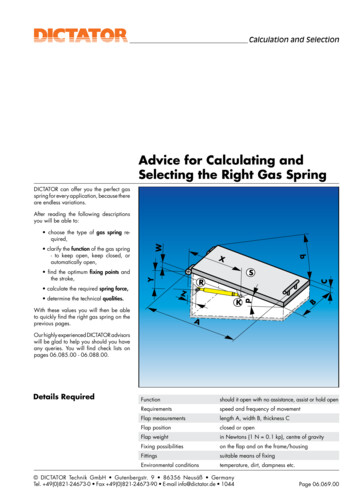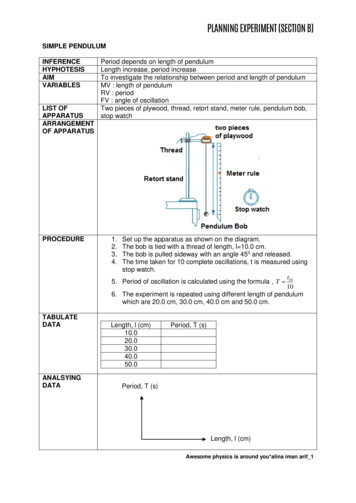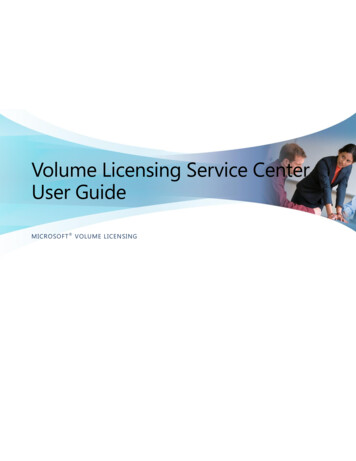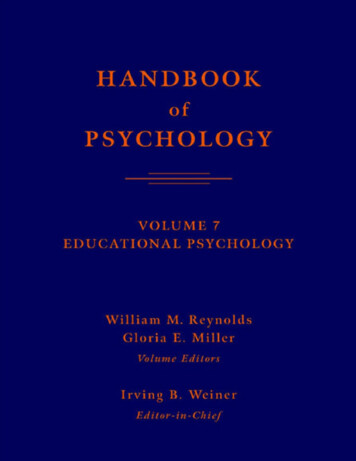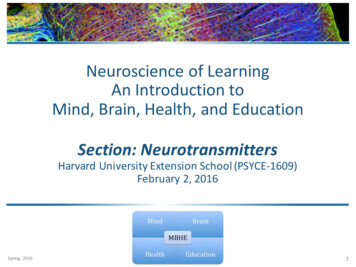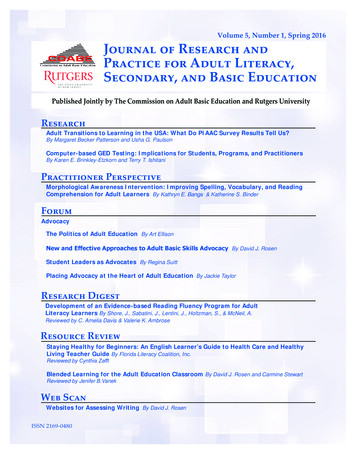
Transcription
Volume 5, Number 1, Spring 2016Journal of Research andPractice for Adult Literacy,Secondary, and Basic EducationPublished Jointly by The Commission on Adult Basic Education and Rutgers UniversityResearchAdult Transitions to Learning in the USA: What Do PIAAC Survey Results Tell Us?By Margaret Becker Patterson and Usha G. PaulsonComputer-based GED Testing: Implications for Students, Programs, and PractitionersBy Karen E. Brinkley-Etzkorn and Terry T. IshitaniPractitioner PerspectiveMorphological Awareness Intervention: Improving Spelling, Vocabulary, and ReadingComprehension for Adult Learners By Kathryn E. Bangs & Katherine S. BinderForumAdvocacyThe Politics of Adult Education By Art EllisonNew and Effective Approaches to Adult Basic Skills Advocacy By David J. RosenStudent Leaders as Advocates By Regina SuittPlacing Advocacy at the Heart of Adult Education By Jackie TaylorResearch DigestDevelopment of an Evidence-based Reading Fluency Program for AdultLiteracy Learners By Shore, J., Sabatini, J., Lentini, J., Holtzman, S., & McNeil, A.Reviewed by C. Amelia Davis & Valerie K. AmbroseResource ReviewStaying Healthy for Beginners: An English Learner’s Guide to Health Care and HealthyLiving Teacher Guide By Florida Literacy Coalition, Inc.Reviewed by Cynthia ZafftBlended Learning for the Adult Education Classroom By David J. Rosen and Carmine StewartReviewed by Jenifer B.VanekWeb ScanWebsites for Assessing Writing By David J. RosenISSN 2169-0480
Journal of Research and Practice forAdult Literacy, Secondary, and Basic EducationPublished Jointly by The Commission on Adult Basic Education and Rutgers UniversityMission StatementThe Journal of Research and Practice for Adult Literacy, Secondary, and Basic Education is publishedjointly three times a year by the Commission on Adult Basic Education and Rutgers University.The journal’s mission is to provide a forum for sharing research, information, theory, commentary,and practical experiences that will improve the quality of services for adult basic education, literacy,and numeracy learners. These learners are found in publicly funded ABE, ESL, and GED programs;volunteer-based literacy programs; community-based literacy programs; family literacy programs;workplace literacy programs; correctional literacy programs; and many other places.The Journal of Research and Practice for Adult Literacy, Secondary, and Basic Education provides a forum for sharing research,information, theory, commentary, and practical experiences that will improve the quality of services for adult basic education,literacy, and numeracy learners. These learners are found in publicly funded ABE, ESL, and GED programs; volunteer-basedliteracy programs; community-based literacy programs; family literacy programs; workplace literacy programs; correctionalliteracy programs; and many other places.Manuscripts should be submitted directly to the Journal through the online submission platform which can be found at: sion/. Submissions should be in Times Roman 12 point font, double-spaced withone-inch margins, and formatted in APA 6th edition style. For full details about maximum page length and other submissionissues please look at the author guidelines on the COABE website: rs%20(1).pdf.The Journal of Research and Practice for Adult Literacy, Secondary, and Basic Education (ISSN:2169-0480) is published threetimes a year (April, August, and December) by the Commission on Adult Basic Education and Rutgers University. The mailingaddress is: COABE, P.O. Box 620, Syracuse, NY 13206. POSTMASTER: Send address changes to COABE, P.O. Box 620, Syracuse,NY 13206.Subscription Information: All subscription inquiries, orders, back issues, claims, and renewals should be addressed to COABEJournal, COABE, P.O. Box 620, Syracuse, NY 13206; telephone: 1-888-44-COABE; fax: 1-866-941-5129; e-mail: journal@coabe.org.Subscription Price: Institutions: 109.00; Non-member individuals: 65.00. For individuals outside of the United States, pleasecontact the above for more information about prices. Claims: Claims for undelivered copies must be made no later than sixmonths following the month of publication. COABE will supply replacement issues when losses have been sustained in transitand when the reserve stock will permit.Member Subscription Information: Members may add a subscription to the journal onto their membership for the additional costof 35.00. Please contact COABE at the following address for more information: COABE Journal, COABE, P.O. Box 620, Syracuse,NY 13206; telephone: 1-888-44-COABE; fax: 1-866-941-5129; e-mail: journal@coabe.org; website: www.coabe.org. Requests forreplacement issues should be made within six months of the missing or damaged issue. Beyond six months and at the discretionof COABE, replacement issues will be supplied when losses have been sustained in transit and when the reserve stock permits.Abstracting and Indexing: Please visit http://coabe.org/html/abeljournal.html under Journal Archives for more information.Copyright Permission: Permission request to photocopy or otherwise reproduce material published in this journal should besubmitted to COABE at journal@coabe.org.Advertising and Reprints: Current advertising rates and specifications may be obtained by contacting Sharon Bonney atsharonbonney@coabe.org or info@coabe.org. To order reprints, please email journal@coabe.org. Acceptance of advertising inthis journal in no way implies endorsement of the advertised product or service by COABE or by Rutgers University. COABEreserves the right to reject any advertising it deems to be inappropriate for this journal.Change of Address: Six weeks advance notice must be given when providing a change of address. Please include the old addressand the new address, together with your name, to journal@coabe.org.Journal Information 1
TABLE OF CONTENTSJournal of Research and Practicefor Adult Literacy, Secondary, and Basic EducationVolume 5, Number 1, Spring 20163Letter From the EditorsResearch528Adult Transitions to Learning in the USA: What Do PIAAC Survey Results Tell Us?By Margaret Becker Patterson and Usha G. PaulsonComputer-based GED Testing: Implications for Students, Programs, and PractitionersBy Karen E. Brinkley-Etzkorn and Terry T. IshitaniPractitioner Perspective49Morphological Awareness Intervention: Improving Spelling, Vocabulary, and ReadingComprehension for Adult Learners By Kathryn E. Bangs & Katherine S. BinderForum: Advocacy57The Politics of Adult Education By Art Ellison61New and Effective Approaches to Adult Basic Skills Advocacy By David J. Rosen64Student Leaders as Advocates By Regina Suitt68Placing Advocacy at the Heart of Adult Education By Jackie TaylorResearch Digest74Development of an Evidence-based Reading Fluency Program for AdultLiteracy Learners By Shore, J., Sabatini, J., Lentini, J., Holtzman, S., & McNeil, A.Reviewed by C. Amelia Davis & Valerie K. AmbroseResource Review80Staying Healthy for Beginners: An English Learner’s Guide to Health Care and Healthy LivingTeacher Guide By Florida Literacy Coalition, Inc.Reviewed by Cynthia Zafft83Blended Learning for the Adult Education Classroom By David J. Rosen and Carmine StewartReviewed by Jenifer B. VanekWeb Scan89Websites for Assessing Writing By David J. RosenThe Journal of Research and Practice for Adult Literacy, Secondary, and Basic Education is publishedthree times per year. You can subscribe anytime during the year. Subscriptions will begin with thefirst issue after your form has been processed. You can subscribe to the journal online by visitingjoincoabe.org and clicking on Journal or by scanning this QR Code with any bar code reader.2Journal of Research and Practice for Adult Literacy, Secondary, and Basic Education Volume 5, Number 1, Spring 2016
Journal of Research and Practice forAdult Literacy, Secondary, and Basic EducationPublished Jointly by The Commission on Adult Basic Education and Rutgers UniversityThe COABE Journal, Celebrating 36 Years as a Major Voice in Adult EducationDear Colleagues,We are very pleased to introduce this issue of the journal at the beginning of our second year serving as the journal’seditors. We are proud of what we have accomplished and glad to see the journal continuing to grow. In particular,we are pleased to have introduced two new features. The first is the Forum section, which focuses on current issuesin the field. Our readers are encouraged to suggest topics or volunteer to participate in future forums. The secondis the continuing publication of a selection of Program for the International Assessment of Adult Competencies(PIAAC) research papers that we believe are particularly relevant to our readers. We are pleased that both of thesenew elements are featured in the spring issue.The first paper in this issue is our second PIAAC paper. In it, Margaret Patterson and Usha Paulson ask howadults continue to learn formally or non-formally and how this learning relates to education levels. This is importantbecause it provides some interesting insights into the participation of learners in a variety of learning activities. Italso explores their barriers and motivators for learning. The PIAAC data provide new opportunities for rich analysesbecause they offer more information and context than was available from previously conducted studies.In the second article, Karen Brinkley-Etzkorn and Terry Ishitani examine the transition of the test of GeneralEducational Development (GED) from paper and pencil to an online format. In particular, they describe how twoprograms adapted to the changes in the test from both teacher and student perspectives.The third article in this issue written by practitioners Kathryn Bangs and Katherine Binder. Bangs and Binderweigh in on some of the arguments associated with how to teach reading to adults and they raise questions abouthow we can adapt research done with children to the needs of adults.This issue also includes a forum discussion about advocacy. Given constant threats of flat or decreased funding,this is an issue that is perennially important to the field. The first article by Art Ellison lays out the importance ofadvocacy within a broader political framework. He goes on to indicate some of the basic steps involved in advocacywhile emphasizing its importance to the adult education world. David Rosen continues this thread and points to someof the newer ways that advocacy can be accomplished in a media savvy world. Regina Suitt provides an example ofthe kinds of advocacy efforts conducted by her program in Pima County, Arizona. Finally, Jackie Taylor summarizesthese disparate approaches and provides a blueprint for thinking about advocacy for the future.As usual, we have outstanding columns and reviews in this issue. David Rosen’s Web Scan column provides somewebsites for assessing writing which provides an excellent resource for teachers. We have included two book reviews inthis issue. In the first, Cynthia Zafft reviews the latest installment in the Staying Healthy curriculum series publishedby the Florida Literacy Coalition. This much needed work is designed for English Speakers of Other Languages(ESOL) and Zafft cogently covers its strengths and weaknesses. Vanek reviews a second book, Blended Learning forthe Adult Education Classroom by David Rosen and Carmine Stewart.Finally, this issue’s Research Digest article is written by Amelia Davis and Valerie Ambrose. They examine recentresearch on an evidence-based reading program by discussing its research design and its applicability for practitioners.Sincerely,Amy D. RoseAlisa BelzerHeather BrownCo-Editor Co-Editor Co-EditorLetter from the Editors 3
Journal of Research and Practice forAdult Literacy, Secondary, and Basic EducationPublished Jointly by The Commission on Adult Basic Education and Rutgers UniversityConsulting EditorsEditorial Teamjournal@coabe.orgAmy D. Rose, Co-EditorNorthern Illinois UniversityDeKalb, ILAlisa Belzer, Co-EditorRutgers UniversityNew Brunswick, NJHeather Brown, Co-EditorUniversity of North Carolina at CharlotteCharlotte, NCNora Devlin, Editorial AssistantRutgers UniversityNew Brunswick, NJEditorial Advisory BoardAlisa BelzerRutgers UniversityJim BergerWestern Kentucky UniversityDaphne GreenbergGeorgia State UniversityRenae HarrisonCOABEAmy D. RoseNorthern Illinois UniversityDavid J. RosenNewsome AssociatesJoAnn WeinbergerCenter for LiteracyStaffSharon Bonney, Executive Directorinfo@coabe.orgMichelle Chiles, Office ManagerMaria Polinsky, Graphic Designer4Matiul Alam, University of British ColumbiaSonya L. Armstrong, Northern Illinois UniversityTannis Atkinson, University of WaterlooHal Beder, Rutgers UniversityAaron Benavot, UNESCO and University at Albany-SUNYJim Berger, Western Kentucky UniversityStephanie Doyle, Victoria University of WellingtonBrendaly Drayton, Pennsylvania State UniversitySam Duncan, UCL Institute of EducationConnie Eichhorn, Metropolitan Community CollegeSusan Finn Miller, Lancaster-Lebanon Intermediate Unit 13Barbara Garner, Jewish Vocational ServiceElisabeth Gee, Arizona State UniversityGabrielle Gerhard, Curriculum Research GroupLynda Ginsburg, Rutgers UniversityDaphne Greenberg, Georgia State UniversityAllen G. Harbaugh, Boston UniversityTom Heaney, Adult Learning UnleashedBob Hughes, Seattle UniversityErik Jacobson, Montclair State UniversityD. Michelle Janysek, Texas State UniversityCathy Kozlowicz, Literacy Council of Greater Waukesha, Inc.Marguerite Lukes, City University of New YorkLarry G. Martin, University of Wisconsin-MilwaukeeNancy E. McEachran, Bellevue CollegeDaryl F. Mellard, University of KansasJ. Ryan Monroe, Carlos Rosario International Public Charter SchoolRon Mottern, Mottern InstituteAndres Muro, El Paso Community CollegeAndy Nash, World Education, Inc.Robert E. Nolan, Oklahoma State UniversitySusan Noyes, University of Southern MaineRichard Orem, Northern Illinois UniversityMargaret Becker Patterson, Research Allies for Lifelong LearningDolores Perin, Teachers College, Columbia UniversityEsther Prins, Pennsylvania State UniversityJohn R. Rachal, University of Southern MississippiRobert F. Reardon, Texas State UniversityStephen Reder, Portland State UniversityPetra A. Robinson, Louisiana State UniversityLeah Katherine Saal, Loyola University MarylandJohn Sabatini, Educational Testing ServiceSteven W. Schmidt, East Carolina UniversityJoni Schwartz, LaGuardia Community CollegeMarilyn J. Shaw, Sharing, Inc.Jane R. Shore, Educational Testing ServiceCristine Smith, University of Massachusetts-AmherstThomas J. Smith, Northern Illinois UniversityKarin Sprow Forté, Penn State HarrisburgMaurice Taylor, University of OttawaLyn Tett, University of HuddersfieldRobert G. Thomas, Central Coast Adult SchoolBarbara Van Horn, Pennsylvania State UniversityLurong Wang, University of TorontoJoAnn Weinberger, Center for LiteracyJeff Zacharakis, Kansas State UniversityCynthia Zengler, Ohio Board of RegentsMary Ziegler, University of TennesseeJournal of Research and Practice for Adult Literacy, Secondary, and Basic Education Volume 5, Number 1, Spring 2016
Adult Transitions to Learning in the USA: What Do PIAAC Survey Results Tell Us?RESEARCHAdult Transitions to Learning in the USA:What Do PIAAC Survey Results Tell Us?Margaret Becker PattersonUsha G. PaulsonResearch Allies for Lifelong LearningThis paper was commissioned by American Institutes for Research, funded through a contract with National Centerfor Education Statistics (NCES).AbstractThe Programme for the International Assessmentof Adult Competencies (PIAAC) assessed literacy,numeracy, and technology-related skills of adultsand found skill levels of US adults are well below theinternational average. In a world where advancedskills are requisite to workplace competitiveness,low skills are a danger sign. An initial PIAACfinding was that half of US adults do not completea postsecondary degree. A question remains: doadults continue to learn purposefully—that is, eitherformally or non-formally—after leaving secondarysettings, and how does learning relate to theireducation levels? A related purpose of the paper isto describe learning types that adults pursue. Thepaper also investigates barriers to and motivatorsfor learning. Implications for adult educators arediscussed.OECD released initial findings fromthe Programme for the InternationalAssessment of Adult Competencies(PIAAC) in 2013. PIAAC assessed literacy, numeracy,and technology-related skills of adults age 16 to 65in 24 countries. According to PIAAC assessmentdata, skill levels of U.S. adults are well belowinternational averages and vary substantially byeducation background. In a world where advancedskills are requisite to workplace competitiveness, lowskills are a danger sign—particularly for adults whoface economic challenges. Another initial PIAACfinding was that half of U.S. adults do not completea postsecondary degree (Kis & Field, 2013).Even so, adults do not necessarily stop learning(OECD, 2013). The first aim of this paper is toexamine PIAAC data by asking: do adults continueto learn purposefully—that is, either formally or nonformally—after leaving secondary settings, and howdoes purposeful learning relate to their educationlevels? Addressing this question will identify thecircumstances in which adults do or do not learn—Research5
Patterson & Paulsonand insights into learning gaps with major economicimplications.Another aim of the paper is to describe learningtypes that adults pursue, such as gaining basic skills,postsecondary coursework, or on-the-job training.The paper also investigates barriers to learningthat adults face and their motivators for learning.Implications for adult educators are discussed.Research QuestionsFour research questions were developed for thispaper:1. How do Learners in each of three educationlevel groups differ from Non-Learners, bydemographic characteristics, skill levels, andeducational and employment background?2. What types of formal and non-formal learningdo Learners report pursuing?3. What barriers to learning do Learners andNon-Learners report?4. What personal-interest and job-relatedmotivators for learning do Learners and NonLearners report?Literature ReviewThe literature on learning describes adult learnersand offers definitions for formal and non-formallearning. We note situational, institutional, anddispositional barriers that can deter learning. Weround out the review of literature by describingmotivators for learning.Transitioning Adult LearnersAdult learners by definition partake of learningactivities which promote “any sustained changein thinking, values, or behavior” (Cranton, 1992,p.3). Participation in adult learning in the pastthree decades has grown. Researchers cite social6and economic forces such as increases in women inthe workforce, rapidly advancing technologies, andworkplace change as main reasons (Autor, 2014;Ross-Gordon, 2011). Adult learners are diverse in age,gender, socioeconomic status (SES), and educationalbackground (Hansman & Mott, 2010).Participation in learning, however, has not grownevenly in adult subpopulations. Increasing numbersof learners at non-traditional ages (Patterson, Zhang,Song, & Guison-Dowdy, 2010; Ryu, 2010) and morewomen are participating in learning (NCES, 2006and 2007). Early PIAAC findings noted skills gapsbetween older and younger adults and educationattainment disparities by gender (OECD, 2013). Morein-depth PIAAC analyses by age or gender can add tothe knowledge base of adult learning participation.Another indicator for disparity in learning is theconnection of SES with assessed skill levels. “Largescale national and international population surveysthat include assessments of adult literacy typicallyreport strong positive correlations among literacyproficiency, educational attainment, employment,and earnings” (Reder, 2013, p. 20). OECD (2013)cited low adult literacy and numeracy skills inexplaining relatively weak U.S. performance onPIAAC assessments. Having basic skills is tied toeconomic productivity along with personal and socialwell-being (Reder, 2010).A gap by SES may be widening. Autor (2014)notes that an earnings “inequality” between U.S.college and high school graduates has more thandoubled in 30 years. Though entering employeeswith high skill levels earn more both initially andover time (Reder, 2010), those in poverty have leastaccess to learning (Ginsberg & Wlodkowski, 2010).SES may sway high school dropout enrollment inpostsecondary education (PSE) more than any otherfactor (Almeida, Johnson, & Steinberg, 2006).Two types of settings are formal learningand non-formal learning (Merriam, Caffarella, &Journal of Research and Practice for Adult Literacy, Secondary, and Basic Education Volume 5, Number 1, Spring 2016
Adult Transitions to Learning in the USA: What Do PIAAC Survey Results Tell Us?Baumgartner, 2007). Skill levels vary widely in bothsettings. Approximately one-fourth of adults withless than a high school education showed the leastparticipation in formal learning, including ABE(Hansman & Mott, 2010). In the LongitudinalStudy of Adult Learning (LSAL), formal learningencouraged learning practices, particularly in adultswith low skills (Reder, 2007; Reder, 2012). In contrast,most adult learners in PSE are women, marriedwith children, or have high family incomes (Cook& King, 2004).Adult learning is frequently job-related—that is, many adults learn to enhance job skills orcareer prospects, either in or outside the workplace(Ginsberg & Wlodkowski, 2010). Initial PIAACdata revealed that most adults with low skills areemployed, so workplace learning may benefitcareer prospects (Kis & Field, 2013). However,participation in work-related courses is higher foradults with a bachelor degree than for those with ahigh school education or less (Hansman & Mott,2010). Businesses tend to prioritize learning for keymanagement and knowledge staff rather than lowskilled employees (Ginsberg & Wlodkowski, 2010).Distance learning (DL), developed mainly totackle deterrents such as time conflicts and remotegeographical locations, can be formal or non-formal,and is increasingly online (Archer & Garrison, 2010).An advantage of DL is its potential to “allow workersto adapt learning to their lives” (Schleicher, 2013,p. 80). An estimated 12.2 million adults enrolledin DL for formal PSE (Parsad & Lewis, 2008),or approximately 20% of formal PSE learners by2008 (Radford, 2011). DL participation was low(4%) among adults obtaining a GED credential;participants tended to be young, employed, andwithout disabilities (Prins, Drayton, & Gungor, 2010).Barriers to Adult LearningFactors that typically play a pivotal role in adultlearners’ participation or non-participation can bedivided into three clusters: situational, institutional,and dispositional (Cross, 1981; Quigley, 2006).Situational barriers result from circumstancesat a given point in time. Lack of child care or ofsupport from close relatives, for example, candeter participation in learning (McAnnaney,2009; Patterson, 2014). Compared with malelearners, female learners tend to be more frequentlyresponsible for household tasks and caregivingand may lack support from partners (Spellman,2007). Little academic preparation, overwhelmingfamily responsibilities, limited finances, and socialor cultural issues may prevent adult learners fromenrolling in PSE (Reder, 2007; Research Allies forLifelong Learning, 2013). Barriers from healthconditions and learning or physical disabilities canalso hamper enrollment in PSE (Patterson, 2014).Institutional barriers occur when educationalprocedures, policies, or practices prevent or limitlearner participation. Examples include lack ofinformation, geographic inaccessibility, inconvenientcourse times, and prohibitive tuition rates. In PIAAC,Schleicher (2013) noted institutional barriers relatedto employer support for learning, especially foremployees with low skills. Participating in PSEmay never happen for adult learners who cannotnavigate through enrollment, program selection,or financial aid processes to get started (ResearchAllies for Lifelong Learning, 2013). First-generationand immigrant PSE learners may have to deal withcultural stereotypes, immigration problems, andlanguage barriers (Spellman, 2007). Currently,researchers have limited knowledge of adults notparticipating in learning, who are seldom includedin studies of barriers to ABE or PSE (Hansman andMott, 2010; Quigley, 2006).Research7
Patterson & PaulsonDispositional barriers refer to learners’ selfperceptions and attitudes about failure in learning.Examples include low confidence, negative pastexperiences, or fear of being “too old” to participate(Patterson, et al., 2010). All three clusters of barriersprovide disincentives to learning.assessment scores. We describe participants overalland offer definitions for subgroups to which we referin analyses.Motivators for Adult LearningMotivators to learn include career-relatedincentives and personal goals. For adult learners,“learning needs to be relevant” to daily tasks, whetherat work or elsewhere (Quigley, 2006, p.121). If adultlearners see how learning translates into securingbetter jobs, higher salaries, or promotions, learningbecomes relevant (Schleicher, 2013). Triggers to startPSE are frequently work-related; some are inspiredby other people’s career roles (Quigley, Patterson& Zhang, 2011). Early PIAAC findings point to aconnection between learning and employee mobilitythat deserves further analysis (Schleicher, 2013).Adults also learn for diverse personal reasons.Feelings of self-worth and self-esteem are keymotivators for adult learners in ABE, ESL, and GEDpreparation (Hansman & Mott, 2010). For peoplewith disabilities, gaining self-determination skillshas been shown to influence success in ABE and PSE(Rocco & Fornes, 2010). Learning is also positivelyassociated with health and social outcomes (OECD,2013). These important connections have yet to beinvestigated in PIAAC data.PIAAC SamplingPIAAC employed a complex sampling design toensure representativeness of the population (OECD,2014). In the United States, 5,010 adults were sampledon laptop computers, with 112 adults unable torespond to the BQ because of low literacy proficiency.Participant scores on assessments were estimatedusing 10 plausible values per content domain. Scoresranged from 0 to 500 and were classified into oneof five levels. Levels for literacy and numeracy were:below Level 1 (0-175), Level 1 (176-225), Level 2(226-275), Level 3 (276-325), and Levels 4/5 (326500). Levels for PSTRE were below Level 1 (0-240),Level 1 (241-290), Level 2 (291-340), and Level 3(341-500; OECD, 2014).PIAAC public-use data files contain perturbedand categorized individual data to ensureconfidentiality. Weights were applied to ensure thateach respondent sampled represented an accurateproportion of the population and that standarderrors would reflect the variability estimated in thepopulation. The population was estimated throughthe American Community Survey of 2010 at 203million adults. More detail on sampling, weighting,BQ administration, and assessments is available inthe PIAAC Technical Report (OECD, 2014).MethodologyOur approach involved secondary analysis ofPIAAC-USA data files. Public-use files we accessedcontain data from an extensive BackgroundQuestionnaire (BQ) and assessments in literacy,numeracy, and problem-solving in technology-richenvironments (PSTRE). Our analyses include crosstabulating BQ survey data and calculating means ofAnalytical ApproachesWe analyzed data using IDB Analyzer software(available for download through the PIAAC Gatewaywebsite) and SPSS. We compared means of plausiblevalues for literacy, numeracy, and PSTRE assessmentsand conducted categorical analyses (primarily crosstabulations). To determine if group differences weresignificant, we calculated effect sizes separately using8Journal of Research and Practice for Adult Literacy, Secondary, and Basic Education Volume 5, Number 1, Spring 2016
Adult Transitions to Learning in the USA: What Do PIAAC Survey Results Tell Us?standard errors generated from software, with a 95%confidence threshold of twice the standard error.PIAAC ParticipantsU.S. PIAAC participants overall ranged in agefrom 16 to 65 years, with a median age group of40 to 44 years. Females made up 50.9% of PIAACparticipants. Reported median income1 was between 29,000 and 36,000 per year. Regionally2 adults camefrom the Northeast USA (18.1%), Midwest (21.6%),South (36.9%), or West (23.4%). Most participantswere native English speakers; 12.1% did not speakEnglish outside the home. Reported health-relatedconditions included difficulty seeing print (11.4%),difficulty hearing conversation (8.7%), and diagnosesof learning disability (8.0%).Skill levels from U.S. PIAAC assessmentsaveraged in the Level 2 range, below internationalaverages. The literacy mean score was 270 (SE 1.0).At this level respondents were tasked with matchingtext and information, paraphrasing, and makinglow-level inferences (OECD, 2014). Numeracy scoresaveraged much lower, with a mean of 253 (SE 1.2) but still in Level 2. PIAAC respondents at thislevel could be expected to respond to mathematicalcontent in common contexts and to apply twoor more steps to solving math problems. PSTREscores averaged 277 (SE 1.1), or at Level 1. Theaverage respondent at that level would be expectedto use commonly available technology applicationsrequiring little navigation to access information tosolve relatively straightforward problems (OECD,2014).U.S. adults taking PIAAC assessments came froma range of educational backgrounds. The medianeducational level of participants was high schoolcompletion. Approximately 80 million, or 41.1% ofadults surveyed in PIAAC, completed high school.A slightly higher percent
89 Websites for Assessing Writing By David J. Rosen TABLE OF CONTENTS Journal of Research and Practice for Adult Literacy, Secondary, and Basic Education Volume 5, Number 1, Spring 2016 The Journal of Research and Practice for Adult Literacy, Secondary, and Basic Education is published three



